You can thicken strawberry jam naturally by combining three essential elements: fruit pectin, sugar, and acid. To maximize natural pectin, use a mix of ripe and slightly underripe strawberries, as underripe berries contain more pectin. You'll need the right sugar ratio (about 1:1 with fruit) to draw out moisture and create a gel network, plus lemon juice for proper acid levels. Keep your mixture at a steady boil between 217-222°F while stirring constantly. The process takes 35-45 minutes, and your jam will continue to thicken as it cools. Master these fundamentals, and you'll reveal the secret to perfectly set preserves.
Natural Thickeners in Strawberries

Jam-making magic starts with the natural thickening properties found in strawberries themselves. When you're making strawberry jam, understanding how these natural thickeners work can help you achieve the perfect consistency without relying on store-bought pectin.
You'll find that adding lemon juice is essential to activating the natural thickening process. The acid in lemon juice helps create a gel-like structure while balancing the jam's sweetness. If you include some lemon zest, you'll get an extra boost of pectin that's concentrated in the peel.
The key to success lies in the cooking method. You'll want to use a long, slow boiling process that reduces moisture and concentrates the natural compounds. When you heat your mixture to 220°F (105°C), you're creating the ideal conditions for thickening. This process typically takes 30-40 minutes of simmering until the mixture becomes thick and syrupy.
Don't forget to stir continuously to prevent burning and guarantee even consistency.
For additional thickening power, you can incorporate natural alternatives like chia seeds or high-pectin fruits such as apples. Using a wide, shallow pan during cooking will increase evaporation and help thicken your jam more effectively.
Remember that your jam will continue to thicken as it cools.
The Science Behind Sugar's Role
Sugar's thickening power plays an essential role in transforming your strawberry mixture into proper jam. When you add sugar to your strawberries, it creates a complex interaction with the fruit's natural pectin, drawing water away and enabling the formation of a gel network. You'll need to maintain a specific sugar-to-fruit ratio, typically 1:1 for strawberry jam, to achieve the right consistency. Many preservers use 7 cups of sugar for optimal results.
The science behind sugar's thickening action involves precise temperature control. As you heat your mixture to 223°F (106°C), the sugar molecules bind with water molecules, allowing pectin chains to come together and form a stable gel structure.
Without enough sugar, you'll end up with runny jam because the pectin molecules won't be able to create proper connections.
Sugar doesn't just thicken your jam; it's also vital for preservation. By binding to water molecules, it reduces the water available for bacterial growth, helping your jam stay fresh longer.
When you reach a rolling boil and achieve a final sugar content between 65-69%, you'll create the perfect environment for both thickening and preservation.
Acid and Gel Formation
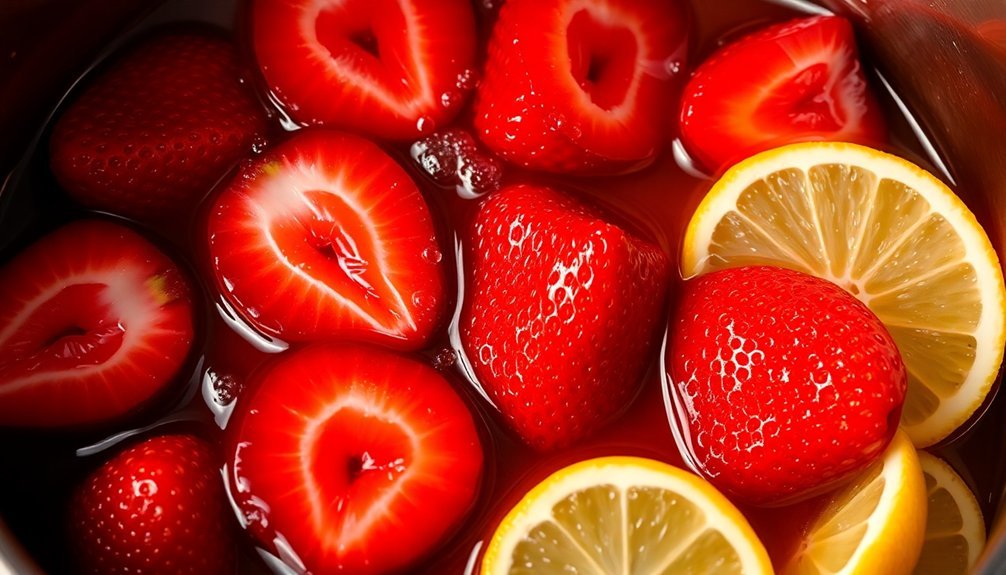
During the essential gel-forming stage, acid plays an important role in transforming your strawberry mixture into thick, spreadable jam. When you add lemon juice to your jam, you're creating the perfect acidic environment (pH 3.1-3.6) that enables pectin molecules to bind together effectively. This binding creates a three-dimensional web that traps the sugary juices and thickens your jam. Boiling over medium-high heat helps concentrate the mixture while the acid works its magic.
| Acid Factor | Effect on Jam |
|---|---|
| Too Little Acid | Jam won't set properly, remains runny |
| Perfect Balance | Forms ideal gel structure, proper thickness |
| Natural Fruit Acid | Enhances existing pectin bonds |
| Added Lemon Juice | Boosts gel formation, guarantees setting |
You'll get the best results by combining ripe and slightly underripe strawberries, as underripe fruit contains more natural pectin. As you heat the mixture, the acid works with the pectin to create stronger molecular bonds. Without proper acidity, even the right amount of heat and sugar won't achieve the desired thickness. If you're using particularly sweet strawberries, you might need to add extra lemon juice to reach the best pH level for gel formation.
Selecting the Right Berries
Building on the importance of proper acidity, selecting the right strawberries is your next key step in creating perfectly set jam. You'll want to focus on using fresh berries, as they contain higher levels of natural pectin compared to frozen ones.
For ideal results, choose a mix where about one-quarter to one-third of your berries are slightly underripe, as these contain more pectin and will help your jam set better.
When selecting your berries, you'll need to carefully inspect them and remove any that show signs of decay, are too hard, or completely green. Hull the berries by removing stems and blossoms, as these can affect both flavor and texture.
While soft berries are usable, they should be balanced with firmer ones for the best consistency.
To prepare your berries, wash them thoroughly and mash them one layer at a time for uniform consistency. It's essential to measure your mashed fruit accurately to maintain the proper sugar ratio.
Always opt for berries that are in season, as they'll provide the best flavor profile for your jam. Remember, while fully ripe berries are acceptable, including some underripe ones will notably improve your jam's setting potential.
Temperature Control for Perfect Setting
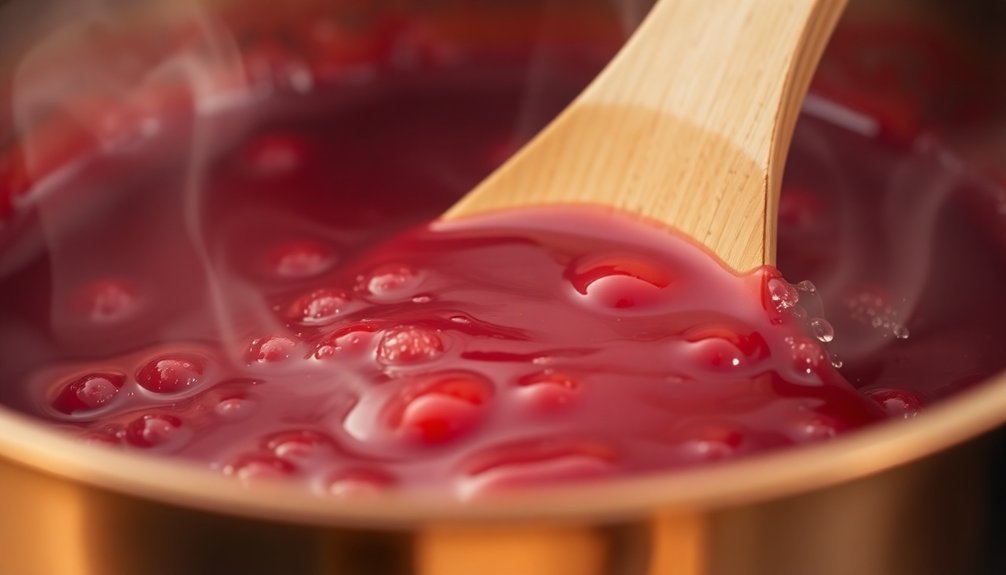
Mastering temperature control is essential for achieving the perfect jam consistency. You'll need to heat your strawberry mixture to 217-222°F (103-106°C) to guarantee proper thickening, though this temperature may vary slightly based on your elevation.
When making jam, you'll want to bring the mixture to a rolling boil while stirring constantly. Don't overboil, as this can break down the natural pectin and create an overcooked taste. Keep your thermometer handy and test frequently until you reach the target temperature range.
| Temperature Stage | What's Happening | What to Look For |
|---|---|---|
| Below 217°F | Insufficient concentration | Runny mixture, no setting |
| 217-220°F | ideal setting point | Thickening begins, leaves trail on cold plate |
| 220-222°F | Final setting stage | Forms definite gel structure |
| Above 222°F | Danger zone | Risk of overcooking, pectin breakdown |
To test the consistency, place a spoonful on a chilled plate and freeze for 2 minutes. If it's ready, you'll see a clear trail when you run your finger through it. If it's still runny, continue cooking and testing every few minutes until you achieve the desired thickness.
Cooking Time Matters
The precise timing of each cooking phase can make or break your strawberry jam's success.
You'll start by allowing your strawberries and sugar to rest for 15-60 minutes, which helps release juices and guarantees proper sugar absorption.
During the initial boiling phase, you'll need to stir constantly for 10-15 minutes as the mixture reaches a rolling boil over medium-high heat.
Next, you'll reduce the heat to a simmer, where the critical thickening process takes place. This phase requires 20-40 minutes of careful attention and frequent stirring.
During this time, excess liquid evaporates while natural pectin and sugar work together to create the perfect consistency. You'll notice the mixture gradually becoming more concentrated.
You can test your jam's thickness by placing a small amount on a cold plate. If it's still too runny, continue simmering for a few more minutes.
Remember that your jam will thicken further as it cools, so don't overcook it.
The combination of proper sugar ratios and fresh lemon juice helps activate the natural pectin, guaranteeing your jam sets properly without artificial additives.
Testing Jam Consistency
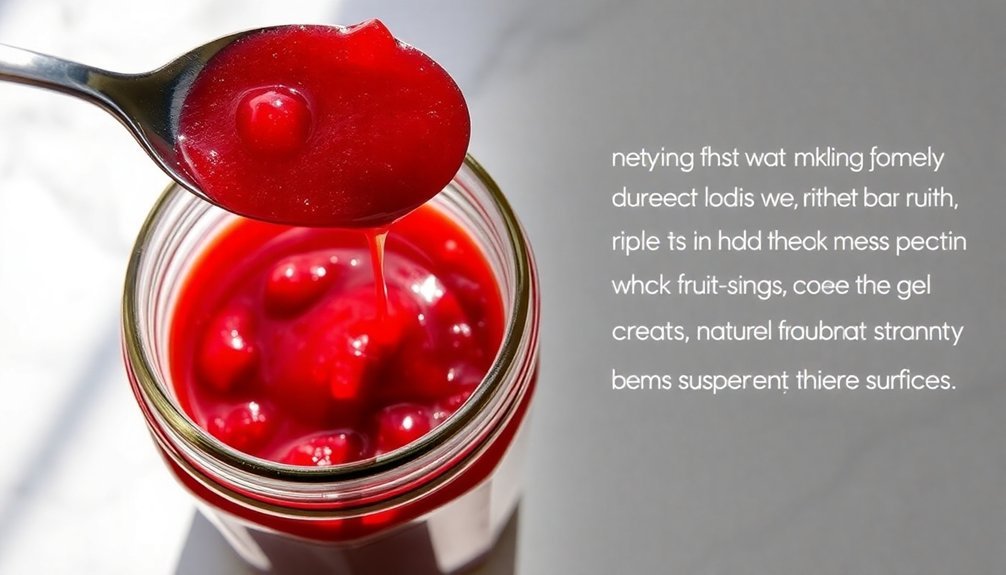
Once your jam has simmered for the recommended time, you'll need reliable methods to check if it's ready. The most common technique is the plate test, where you'll drop a small amount of jam onto a chilled plate and refrigerate it briefly. When you push your finger through it, the surface should wrinkle and not flood back.
You can also try the cold plate and spoon method. Draw a spoon through jam that's been placed on a frozen plate – if the line stays separated and wrinkles when touched, your jam has reached the right consistency.
For a quicker check, use the spoon and sheet method by lifting a spoonful of jam and watching how it falls. If it drops in a thick sheet rather than runny drips, you're on the right track.
The most precise approach is using a thermometer. Your jam will typically set when it reaches 105°C, though you'll need to account for your altitude's effect on water's boiling point.
While this method's the most straightforward, you might still want to combine it with one of the other tests to guarantee perfect results.
Fruit to Sugar Ratios
Proper ratios of fruit to sugar serve as the foundation for perfectly thickened strawberry jam. You'll need 6 cups of sugar for every 8 cups of mashed strawberries to achieve the right consistency. If you reduce this sugar ratio, your jam won't set properly, as sugar plays an essential role in activating the natural pectin in strawberries.
When you're working with strawberries, which naturally contain less pectin than other fruits, maintaining the correct sugar ratio becomes even more vital. The sugar doesn't just sweeten your jam – it helps reduce water content and concentrates the fruit's natural pectin during cooking.
| Fruit Type | Sugar Needed |
|---|---|
| Ripe Strawberries | More sugar required |
| Under-ripe Strawberries | Less sugar needed |
| Mixed Berry Blend | Standard ratio |
| High-pectin Fruits | Can reduce sugar |
| Low-pectin Fruits | Must maintain full sugar |
You can enhance the thickening process by adding lemon juice, which provides the acidity needed to activate pectin. Remember that while both fresh and frozen strawberries work, fresh berries will give you the best results in achieving that perfect jammy consistency.
Common Thickening Mistakes
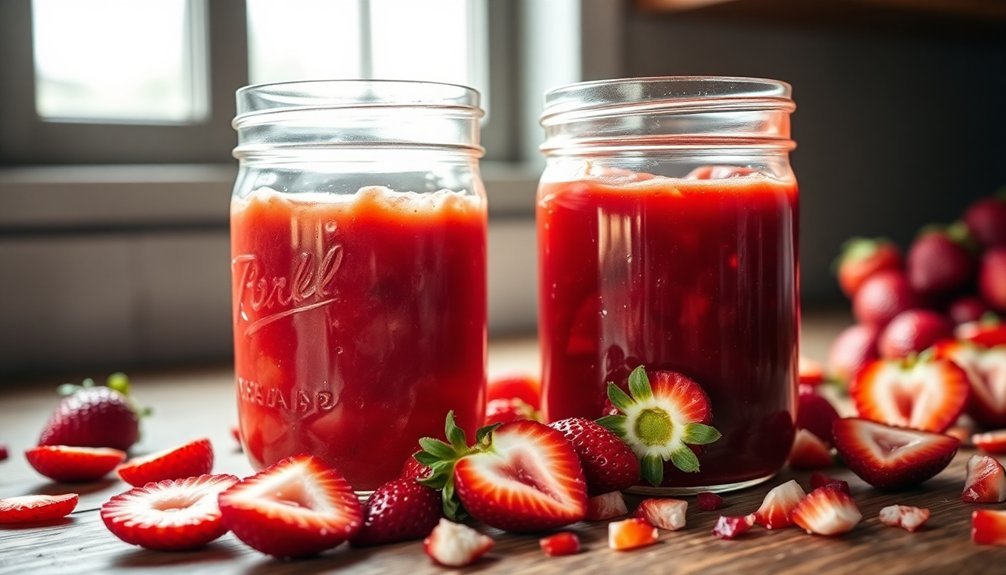
Even with the right fruit-to-sugar ratios, making perfectly thickened strawberry jam requires avoiding several common pitfalls. You'll need to guarantee sufficient cooking time, typically 35-45 minutes, as undercooking prevents proper thickening.
Monitor your jam's consistency regularly during the cooking process to achieve the right texture. Your sugar content plays a vital role in activating the fruit's natural pectin and preserving the jam. If you don't use enough sugar, you'll find your jam won't set properly because sugar binds with water and helps pectin chains form.
Similarly, you need to add the right amount of lemon juice, as it provides the acidity necessary for gel formation. Too little won't help the jam set, while too much can affect both texture and flavor.
Be careful when selecting your strawberries. If you're using overripe fruit, you'll have less natural pectin to work with, making it harder for your jam to thicken. Choose slightly underripe strawberries instead, as they contain more pectin.
Fresh fruit will generally give you better results than frozen, and remember that fruit moisture content can affect your cooking time.
Traditional Preservation Methods
To maximize natural pectin development in your strawberry jam, you'll want to combine the fruit with lemon juice and zest, which provide additional pectin from the citrus peel.
Adding sugar at the right moment helps draw out moisture from the strawberries while creating the perfect environment for pectin molecules to form their characteristic gel structure.
You can achieve the ideal preservation balance by maintaining a careful ratio of sugar to fruit, typically using 3/4 cup of sugar for every cup of crushed strawberries.
Natural Pectin Development Methods
Traditional jam-making techniques rely heavily on natural pectin sources to achieve the perfect thickness without artificial additives. You'll find that fruits high in pectin, like apples and citrus, can naturally thicken your strawberry jam when combined during cooking. By adding green apple pieces or citrus peels to your jam mixture, you're introducing natural pectin that will help create the perfect consistency.
| Pectin Source | Preparation Method | Expected Results |
|---|---|---|
| Green Apples | Dice and cook with berries | Medium-firm set |
| Citrus Peels | Simmer in hot water solution | Firm set |
| Apple Pomace | Extract in hot water bath | Very firm set |
| Lemon Seeds | Soak overnight in water | Light set |
| Orange Peels | Slow simmer with berries | Medium set |
To extract maximum pectin, you'll want to use a long, slow boiling process. Start by simmering your chosen pectin source in water, then strain the mixture before adding it to your strawberries. If you're using citrus peels, let them soak overnight before cooking to release more pectin. Remember that different fruits require varying cooking times to achieve the right thickness, so you'll need to adjust your simmering time accordingly.
Fruit Sugar Preservation Balance
Success in preserving strawberry jam depends heavily on achieving the right balance between fruit and sugar content. The traditional approach calls for a 60/40 ratio of fruit to sugar by weight, which not only helps preserve the jam but also creates the perfect consistency.
You'll want to use a scale to measure your ingredients precisely, as this ratio is essential for both preservation and texture.
When you're making your jam, start by macerating the strawberries with sugar overnight. Layer them alternately in your container and refrigerate, which allows the sugar to draw out the fruit's natural juices. This process creates a syrup that you'll later cook to 230°F for the ideal preserve consistency.
During cooking, you'll need to skim off any foam that forms on the surface to guarantee clarity and prevent contamination. Once your strawberries become translucent and the syrup thickens, you've reached the right consistency.
You can test this by placing a small amount on a frozen plate. After processing in a water bath, your properly preserved jam will keep for at least a year when stored in a cool, dark place.
Frequently Asked Questions
Can I Use Honey or Artificial Sweeteners Instead of Sugar?
You can use honey, but you'll need extra pectin since it won't thicken like sugar does. Avoid artificial sweeteners as they don't gel properly and can turn bitter when cooked for long periods.
Does Altitude Affect How Strawberry Jam Thickens Naturally?
Yes, altitude affects your jam's thickening. Since water boils at lower temperatures in high altitudes, you'll need to cook your jam longer. Add 5-15 extra minutes depending on your elevation above sea level.
How Long Can Homemade Strawberry Jam Be Stored Without Added Pectin?
You can store your homemade strawberry jam for up to 1 year in a cool pantry when properly canned, 1 month in the fridge once opened, or up to 18 months in the freezer.
Will Crushing Strawberries Differently Affect How the Jam Thickens?
Yes, how you crush strawberries affects thickening. When you crush them finely, you'll release more natural pectin and get faster thickening. Coarse crushing creates varied texture but may need longer cooking time.
Can Frozen Strawberries Be Used to Make Naturally Thickened Jam?
You can use frozen strawberries, but they'll make natural thickening more difficult since freezing reduces pectin content. You'll need longer cooking times and may not achieve the same thickness as with fresh berries.
In Summary
When you're making strawberry jam without pectin, you'll rely on the fruit's natural composition and proper technique. You've learned how sugar, acid, and natural pectin work together to create the perfect set. Remember to choose ripe berries, maintain the right temperature, and follow correct fruit-to-sugar ratios. By avoiding common mistakes and using traditional methods, you'll create deliciously thick jam every time.

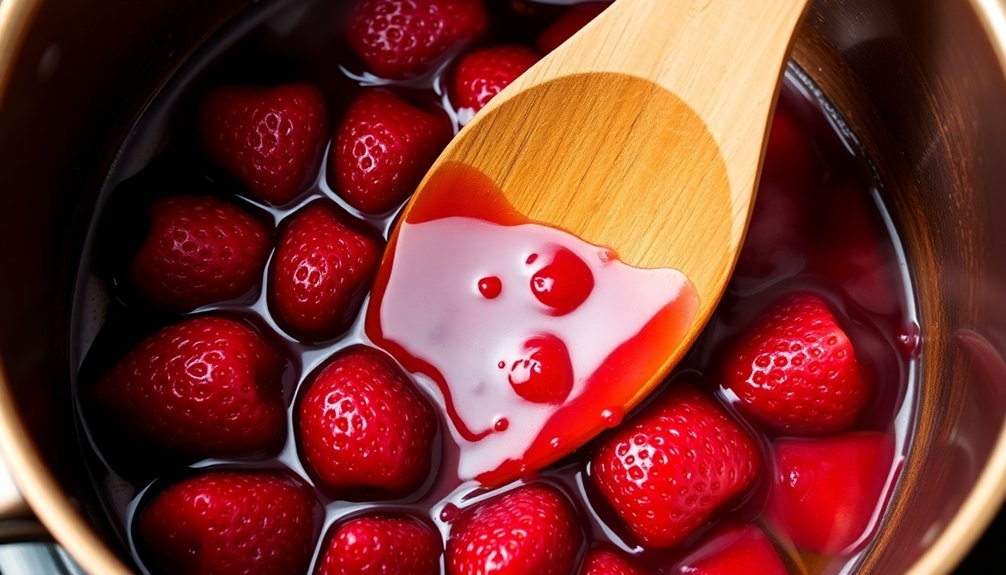



Leave a Reply